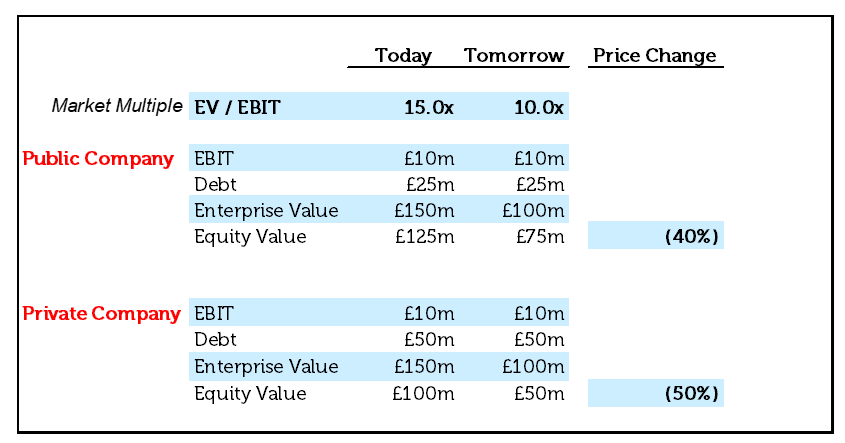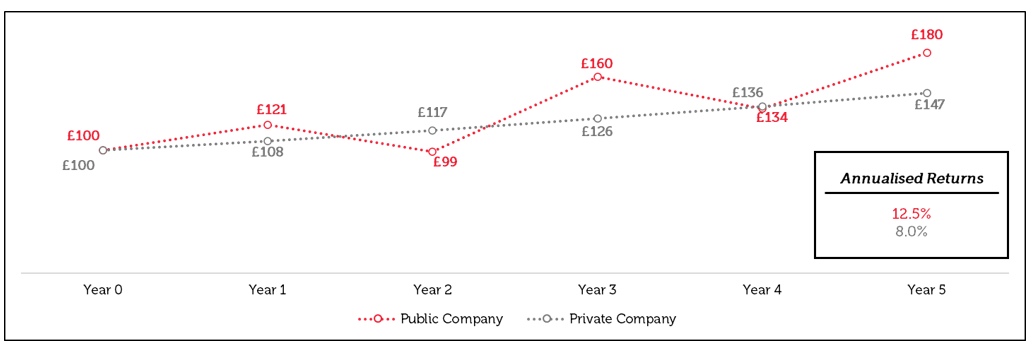NEWS

30 May 2025 - A Super Strategy
|
A Super Strategy Marcus Today May 2025 |
|
Every time there is a significant market event I have friends ask me the same set of questions. Why is this happening? Is it too late to sell? I don't have any shares, should I care? The more important question is - how could I have avoided this? Better still - think the stock market doesn't affect you? Think again. Foreword: In my friendship group there are two types of people. 10% are interested in the stock market. Know what an ETF is and buy and sell shares. The other 90% have never traded in their life, think a bear market is where you can buy a bear and don't really understand what I do at Marcus Today. Should that group be interested in the stock market? If they are 30 years old they will on average have $50,000 in their superannuation account. Where is that money invested? In the stock market! The performance of their super and the amount they will retire with are highly dependent on it. This article is focused on them. PART 1: SHOULD YOU CARE? Working in the stock market, the only time I get asked for advice from friends is when there's a major correction. The same question always comes up: "Is it too late to sell?". It happened last month (tariff tumble), it happened last year (carry trade three day flush) and would have happened in Covid. When you can see an account with thousands of dollars dropping 5% in a day, this question isn't surprising. The question no one asks (but should): "How could I have avoided this?" Even more important: "What difference would it make to my retirement by asking that question?".
I know most people under 35 struggle to look far ahead enough to care. When half of my friends are wondering how they will be able to afford a house or start a family, you can forgive them for not paying much attention to something that automatically gets taken out of their payslip and can't be touched for another 30 years. The purpose of this article is to say "you 100% should care". Given the fabulous opportunity my generation has from super - tax benefits, long runway, the eighth wonder of the world (compounding interest), considering we 'missed' the housing market boom, it is worth investigating the full potential of what your balance could be upon retirement. I used to be an engineer, so let's do a few simple calculations and see what difference each % return makes over the course of a work life. To simplify the formula, I've made the following (conservative) assumptions:
The chart below shows the final super balance you can expect after year 35 with an 8% return. Both the S&P 500 total return index and All Ords Accumulation index average 9-11% (over 30Y) but you have management and administration fees to include. That aside:
One percent makes a huge impact in other words when your runway is 35 years, and again, this is a conservative estimate.
The good news is even with 8% average return you'll be retiring with ~$3.5 million. You can see why the government has been steadily trying to increase the mandatory super contribution (goes from 11.5% to 12% in July). If every Australian had the above hypothetical work life there would be no need for the pension. Last FY it accounted for 37% of all government spending. Assuming an inflation rate of 2.5% (the average in Australia for the last 10Y), this $3.5 million equates to a present value of $1.45 million. Not bad. Marcus once estimated how much you really need to retire was around $2 million. Time to ask for that promotion! Sounds OK, BUT. There are two catches. This calculation assumes 100% of your super is invested in either the S&P 500 total return or the All Ords Accumulation index. Something most super companies will call 'high risk' and try talk you out of. The average 'balanced' Australian superannuation account only has 35% invested in international equities and 30% in Australian equities. The rest is private equity, infrastructure, property, fixed interest and (dare I say it) cash. If you're in a balanced super account your return could shrink from ~8% to ~6% ('defensive' drops it to 5%!), and that $1.45 million retirement fund falls to $0.9 million. Probably enough to live on. But not enough for the European holiday, grand-children school fees or kitchen renovation. In short:
To combat this you need to switch to a 100% equities investment strategy. Check your current provider allows this. If not. Time to move. The second catch...tax. Cannot be ignored but I'll try keep it simple. All contributions to super (below the $30k pa concessional cap) are taxed at 15%. All realised investment gains are taxed at 15% (I'm not assuming shares will be held for longer than 12 months, so no 50% CGT concessions). All in all, this is far better than paying at your marginal rate but is still significant. Factoring in these rates, your $0.9 million in a balanced fund drops to just $670k. PART 2: THE ROCKET $670k doesn't sound like much, so now we ask - can you do better? The next chart shows the final super balance you can expect after year 35 for four different returns ranging from 8% to 14%. At 14% the balance jumps from $3.5 million to $15 million or from $1.4 million to $6.2 million in today's terms. At 18% the line would look like a rocket.
Accounting for the tax rates above these are the final balances and net present value for returns ranging from 8% to 14%.
And the difference one percent makes now?
Why does all this matter? Is 14% possible? The Marcus Today Strategy Portfolio has returned ~20% since inception in 2018. We can't guarantee future returns will match past returns of course but even taking 12% - your retirement super level will go from $2.3 million to $5.2 million ($2.2 million present value) and that's not even touching on voluntary contributions. All hypothetical of course. No one knows the future but if you had the opportunity to increase your returns why not take it?
CONCLUSION Three things for you to do:
Bonus: If you want to become a better self-guided investor. Read Market Strategy a few times a week. We call it learning by osmosis. Oliver Matthew - Senior Analyst & Editor |
|
Funds operated by this manager: |

29 May 2025 - What Trump's trade war means for EM local currency bonds
|
What Trump's trade war means for EM local currency bonds abrdn May 2025 With index total returns of 3.3% in April and 7.7% year-to-date [1], emerging market (EM) local currency (LC) bonds have been resilient in the face of Trump's tariff shock. This is especially when compared to equities, with the S&P 500 Index at one point down by as much as 18% during April. What explains the outperformance of EM LC bonds, and to what extent might this be sustained? Local EM bond impactLocal currency bond returns include local bond returns and local currency (FX) returns. Country bond yields tend to move lower (bond prices rise) whenever local growth and inflation decline, making local interest rate cuts more likely. Trump's tariffs seem to tick both boxes - global growth, including in EM countries, is expected to weaken while non-US inflation is set to decline as Chinese goods formerly destined for the US are sold elsewhere at lower prices. The recent drop in oil prices due to global growth worries is also disinflationary. Local EM currency impactThe impact of sharply increased US tariffs on EM local currencies is less straightforward. Before Trump was re-elected, markets expected that US policy changes would likely be dollar-positive. The thinking was that increased tariffs would narrow the US trade deficit, while Trump's pro-growth policies would put upward pressure on US interest rates, supporting the US dollar. However, the tariff saga has significantly weakened the US dollar, which fell nearly 5% versus the euro in April. Conversely, as shown in Chart 1, the effect on EM local currencies has been favourable.
Chart 1: Selected year-to-date EM local currency performance versus USD (% change) The main reason for the US dollar's weakness is that while higher US tariffs were widely anticipated, the extent of the hikes and the disorderly manner of their implementation took most by surprise. With input costs expected to soar, the inflationary impact will likely be greater. The US growth outlook has also weakened significantly, with a recession now a possibility. Why recent USD weakness could persistAmid growing concerns about stagflation and generally increased US policy and economic uncertainty, US equities have especially borne the brunt of the tariff fallout. While this reflects increased domestic selling, we think a major contributor will also have been selling on the part of foreign investors. Over many years, helped by the 'US exceptionalism' narrative, foreign investors have built up very large holdings of US assets, which has certainly helped the dollar. Going forward however, if policy concerns persist, foreign investors could further reduce their still-large US asset overweight and effective long dollar positions. The fact that US equities and the dollar remain historically overvalued on most measures may also be a consideration. Reducing foreign allocation to US assets, or even slowing their accumulation, would likely be negative for the dollar but positive for non-dollar assets, including EM LC bonds. Some caveats for the weak USD caseThere are caveats. Predicting currency moves with any great conviction is always difficult, and betting big against the US dollar hasn't worked for well over a decade. There are also multiple scenarios in which the US dollar could bounce back strongly. For example, recent deals, including the newly announced temporary agreement with China, suggest that 'reciprocal' tariffs may eventually end up off the table, with the baseline 10% rate and some sectoral tariffs remaining. While this would increase costs for US consumers, it may well not be enough to trigger a disruptive recession, fear of which was surely behind some of the dollar's weakness this year. Outlook is about much more than just the dollarEM LC bond returns depend on more than what happens to the US dollar. With an index yield of over 6%, the income contribution will be sizeable [1].Furthermore, country-specific factors will continue be a key performance differentiator, highlighting the need for selectivity. Even with higher US tariffs, country-level impact could vary considerably. For example, if some form of tariff reciprocity were retained, sizeable variations in US tariff differentials between countries could emerge, creating potential US trade winners and losers. Putting everything togetherWe think the Trump tariff shock strengthens the investment case for EM LC bonds. Weakening global growth and falling inflation outside the US should make EM local interest rate cuts more likely, boosting EM local bond returns. On the currency side, foreign investor may look to further diversify their sizeable US asset holdings, especially US equities, in the face of heightened policy uncertainty. This could support EM local currency returns. However, several caveats argue against adopting a high-conviction view on US dollar directionality.
|
|
Funds operated by this manager: abrdn Sustainable Asian Opportunities Fund, abrdn Emerging Opportunities Fund, abrdn Global Corporate Bond Fund (Class A), abrdn International Equity Fund, abrdn Multi-Asset Income Fund, abrdn Multi-Asset Real Return Fund, abrdn Sustainable International Equities Fund |

28 May 2025 - 10k Words | May 2025
|
10k Words Equitable Investors May 2025 Apparently, Confucius did not say "One Picture is Worth Ten Thousand Words" after all. It was an advertisement in a 1920s trade journal for the use of images in ads on the sides of streetcars... Private company M&A valuations have converged with those of ASX-listed emerging companies; a structural shift evident in 52-week highs and lows on the ASX sees gains going to a select group, with CBA being one of the few as lacklustre EPS growth is rewarded with P/E multiple expansion and CBA almost singlehandedly holds up MSCI's Australian index. Overall, EPS estimates for Austalian equities have also been lacklustre but, thanks in part to CBA, the Australian P/E is sitting at elevated levels also seen during the COVID-19 epidemic and the dotcom boom. Meanwhile, there was little market conviction in a 50 basis point cut from the RBA in May (which turned out to be the correct positioning with a 25bp cut announced today). IPO markets remain notably weak in 2025. On the tariff front, US price hikes from goods originating in China were quickly evident relative to those originating elsewhere. EBITDA multiples of unlisted Australian mid-market trades (Nexia MM Index) v. ASX trading multiples 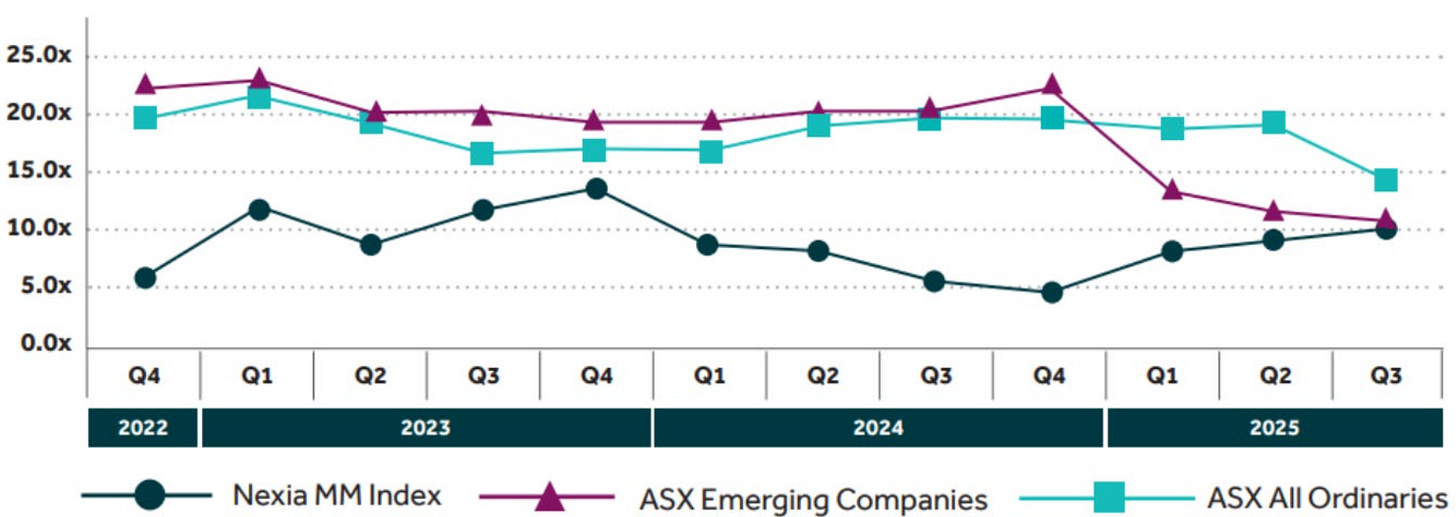
Source: Nexia No. of Australian M&A mid-market transactions and disclosed EBITDA multiple average value by enterprise value (March quarter 2025) 
Source: Nexia S&P/ASX 300 and cumulative 52-week highs - 52-week lows 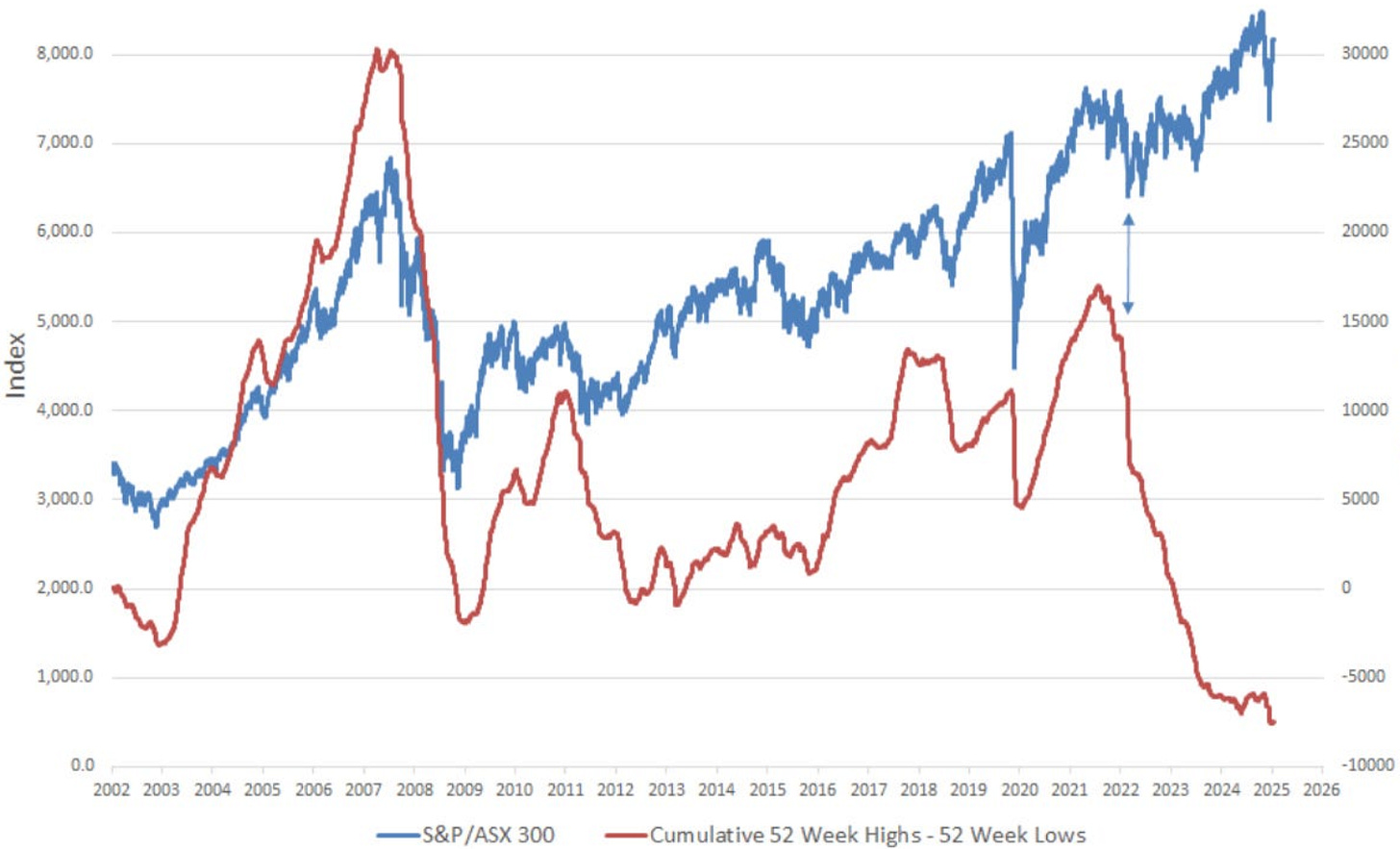
Source: SG Hiscock Forecast EPS (next 12m) and forward P/E multiple of Commonwealth Bank of Australia (CBA) 
Source: TIKR CBA contribution to 12-month return on iShares MSCI Australia (EWA)


Source: Koyfin Australia MSCI forward earnings per share (analysts' average forecasts) 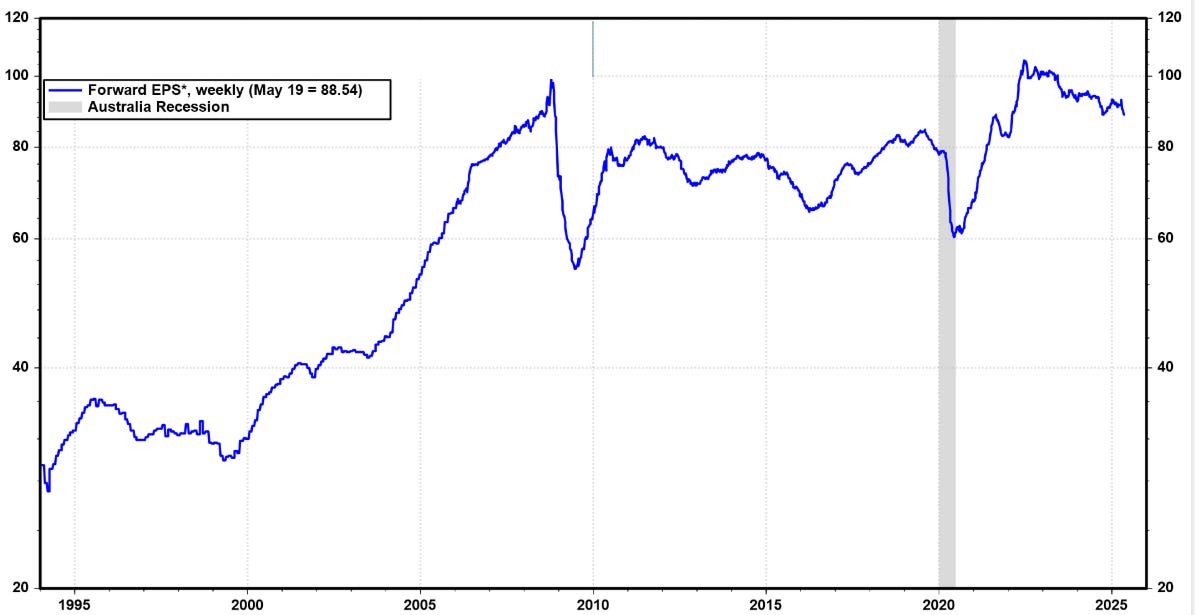
Source: Yardeni Research Australia MSCI forward PE multiple 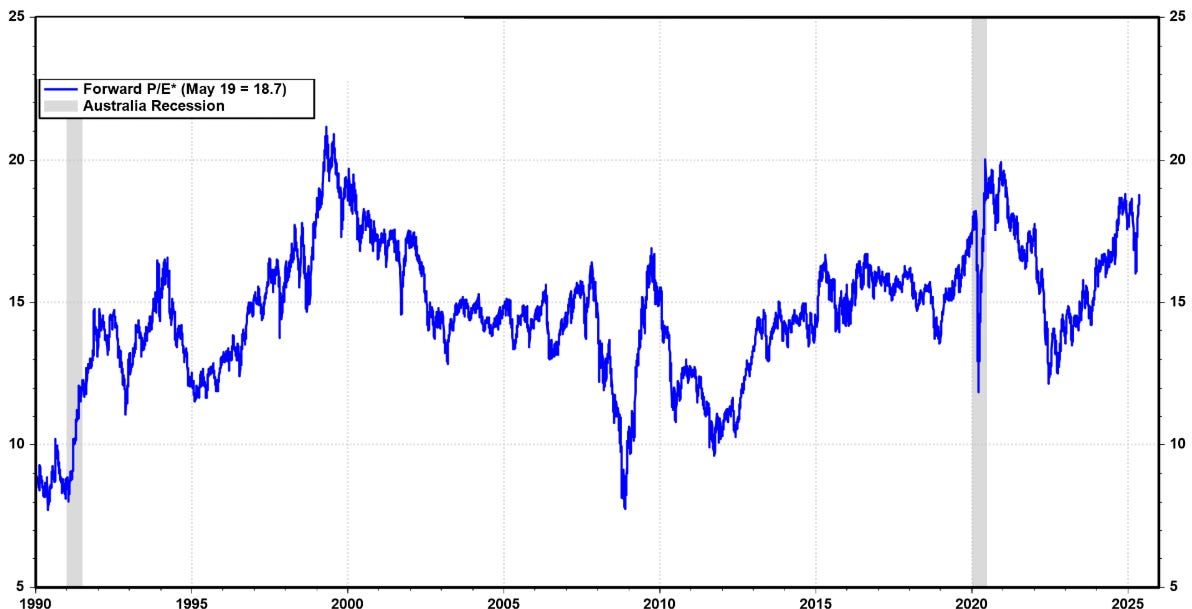
Source: Yardeni Research Expectations for a 50 basis point cash rate cut by the RBA in May were just 51% prior to the decision 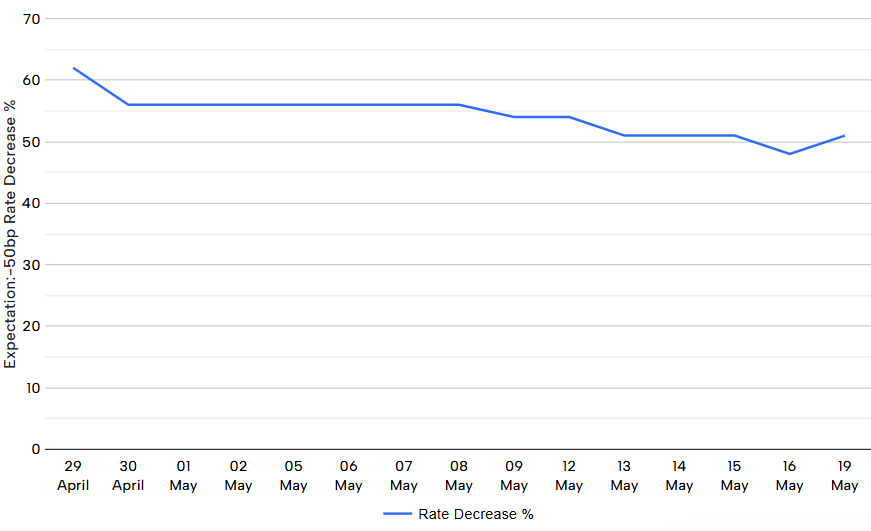
Source: ASX Decline in IPOs year-on-year globally in CY2025-to-date 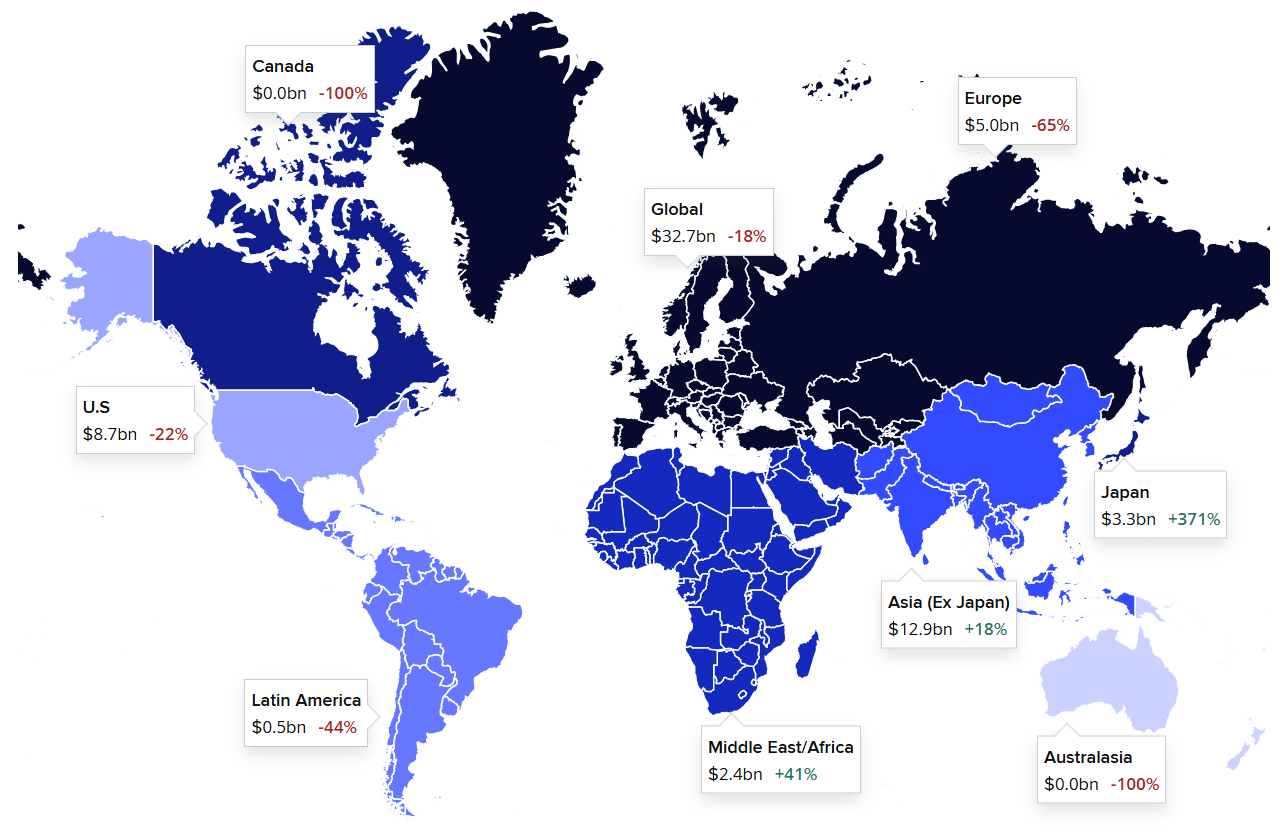
Source: WSJ, LSEG 2025 Australian IPO tracker

Source: Smallcaps.com.au US consumer price indices by country of origin 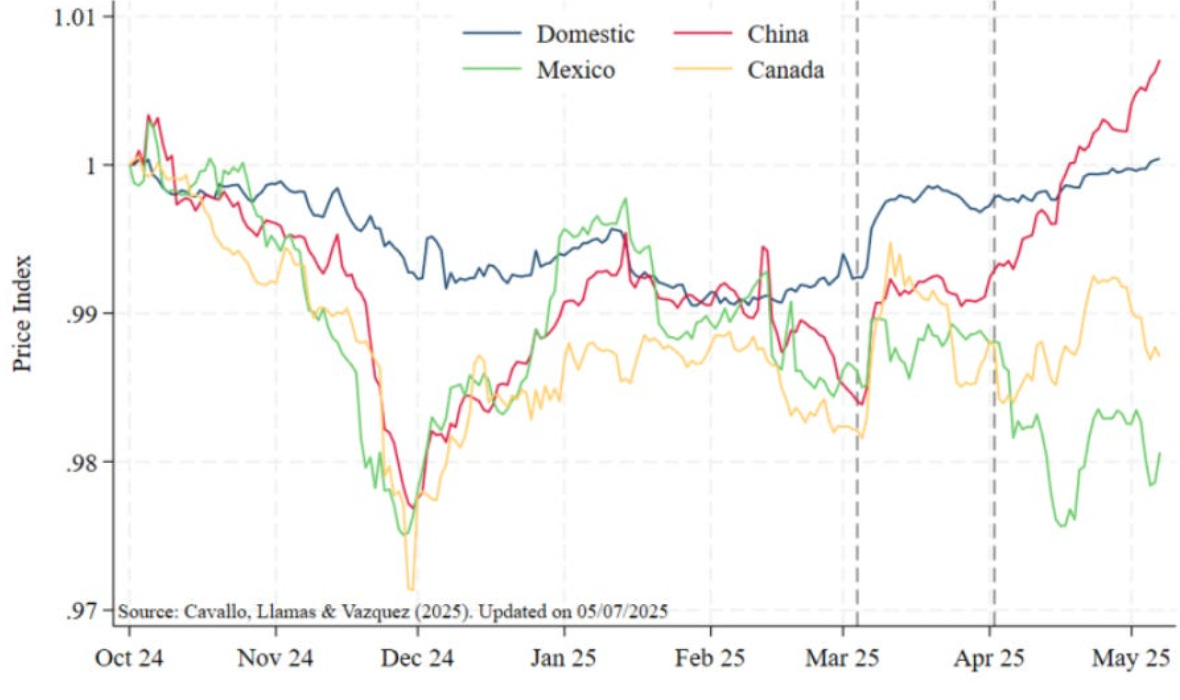
Source: "Tracking the Short-Run Price of US Tariffs," Cavallo et al, May 10, 2025 US retail price indices in affected and unaffected categories 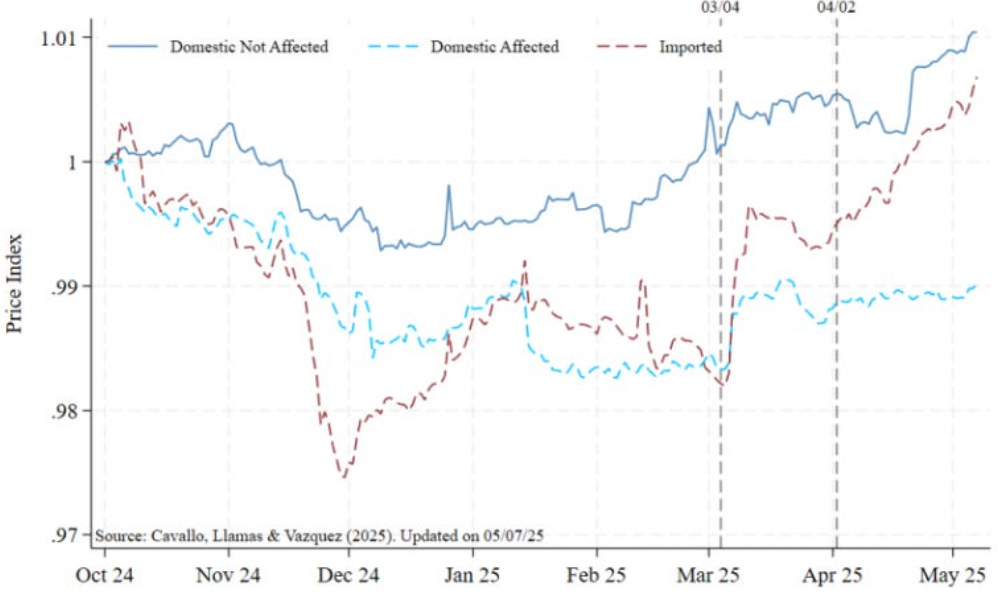
Source: "Tracking the Short-Run Price of US Tariffs," Cavallo et al, May 10, 2025 May 2025 Edition Funds operated by this manager: Equitable Investors Dragonfly Fund Disclaimer Past performance is not a reliable indicator of future performance. Fund returns are quoted net of all fees, expenses and accrued performance fees. Delivery of this report to a recipient should not be relied on as a representation that there has been no change since the preparation date in the affairs or financial condition of the Fund or the Trustee; or that the information contained in this report remains accurate or complete at any time after the preparation date. Equitable Investors Pty Ltd (EI) does not guarantee or make any representation or warranty as to the accuracy or completeness of the information in this report. To the extent permitted by law, EI disclaims all liability that may otherwise arise due to any information in this report being inaccurate or information being omitted. This report does not take into account the particular investment objectives, financial situation and needs of potential investors. Before making a decision to invest in the Fund the recipient should obtain professional advice. This report does not purport to contain all the information that the recipient may require to evaluate a possible investment in the Fund. The recipient should conduct their own independent analysis of the Fund and refer to the current Information Memorandum, which is available from EI. |

27 May 2025 - Trip Insights: Asia

26 May 2025 - Webinar Recording | Impact of Tuesday's RBA rate decision
|
Webinar Recording: Impact of Tuesday's RBA Rate Decision on the Market FundMonitors.com May 2025 |
|
Watch our recent webinar where leading investment professionals discussed the implications of the Reserve Bank of Australia's latest rate decision and its effect on markets. Our expert panel featured:
Gain timely insights into how key sectors are responding and what this could mean for investors. |

23 May 2025 - On the Road with Alphinity Global: The Rising Premium on Certainty
|
On the Road with Alphinity Global: The Rising Premium on Certainty Alphinity Investment Management May 2025 |
|
Over the past several months, our global investment team has embarked on a series of research trips across multiple continents, meeting more than 250 companies in five countries to gain first-hand insights and identify emerging trends. All six team members recently completed another round of visits to the United States ahead of the 1Q25 reporting season. In today's highly volatile environment, this on-the-ground perspective has proven indispensable for staying ahead of rapidly unfolding developments.
Our conversations with management teams spanning Singapore's financial centres and San Francisco's tech corridors to Mumbai's manufacturing hubs and Beijing's policy circles have revealed a striking shift in corporate sentiment. The optimism that characterized the start of the year has been replaced by widespread operational uncertainty, especially since March, as executives navigate unpredictable policy changes and ongoing supply chain disruptions. This environment has prompted many companies to withdraw forward-looking statements, narrow their guidance ranges, or append new disclaimers to their 1Q25 earnings releases considering persistent macroeconomic volatility. In this note, we outline some of the key themes emerging from our recent travels and discuss how our on-the-ground insights are helping us refine our portfolio-balancing a more defensive stance with selective growth opportunities that have been unjustly discounted.
Asia: A Mixed Picture of Challenges and Opportunities
Global Financials: From Recovery and Optimism to Stagflation fears and Volatility Post-election optimism for deregulation and tax cuts initially fuelled a global banking rally at the end of 2024, buoyed by robust deal pipelines and corporate engagement. However, stagflation fears and plunging consumer confidence reversed sentiment by mid-February 2025, freezing corporate activity. Recent 1Q25 results and CEO commentary show limited numerical impact to date, with tariff-driven front-loaded spending creating sporadic activity and heightened volatility boosting trading desks like Morgan Stanley's. On the real estate side, CBRE's result reflected a continued, yet sensitive commercial real estate recovery cycle. The business was buoyed by the strength of its resilient business lines and continued benefit from scarcity within the office sector for capital markets and leasing. Across the Atlantic, Germany's €1 trillion defence and infrastructure package represent a structural break from decades of austerity. A potential growth tailwind for Eurozone banks, including Spanish lenders like CaixaBank. Spain's economy is already outpacing EU peers with 2.5%+ GDP growth likely, and we expect that CaixaBank will be a key beneficiary given its market-leading positions in mortgages, payroll services, and wealth management--sectors poised to compound gains from digital transformation and demographic tailwinds. That said, the spectre of U.S. tariffs on EU goods looms large, potentially offsetting 20-30% of Germany's stimulus benefits and introducing cross-sector vulnerabilities. CaixaBank - Leading retail bank exposed to relative strength of the Spanish economy & seeing strong earnings upgrades
US Industrials - in the eye of the tariff storm The prevailing sentiment among US industrial players in February 2025 closely echoed what we observed during our September 2024 visit. The sector remains on a path toward gradual, measured recovery, rather than a rapid resurgence. Management teams were however cautious, reflecting uncertainties about inflation, tariffs, political instability, and the Chinese economic landscape. While there were some signs of emerging positive momentum, a "low and slow" industrial rebound is more likely. Notably, regions outside the US - particularly Europe and China - may see stronger recoveries, given their steeper prior declines. End markets continue to matter, with aerospace, electric grid and waste operators all remaining relatively positive, while in contrast the environment remains tough for agriculture, transportation and residential housing. Two key themes stood out: tariffs and a short-cycle manufacturing recovery. Companies are preparing for tariff-related cost increases, with some already passing on surcharges and viewing tariffs as an opportunity to raise prices, which likely drives inflationary pressures. A fragile short-cycle recovery was noted despite scepticism regarding the underlying causes, with inventory buildup ahead of tariffs largely dismissed by management teams. Amid these conditions, we remain focused on defensive industrial names such as Waste Connections, the third-largest US waste operator, which recently exceeded 1Q25 estimates and reiterated its FY25 guidance, reporting no material impact from recent macro volatility. Whilst our current exposure to US industrials remains aligned with resilient, high-quality industrials underpinned by resilient end markets, the recent market weakness is starting to throw up exciting opportunities at more reasonable valuations. US Consumer - From reassured to restrained During our US visit in January 2025, consumer management teams described the business environment as "generally positive" with expectations of faster policy execution under a new Trump administration. Supply chains have already notably shifted away from Chinese reliance since the previous Trump administration and any potential impact of tariffs was expected to be partially absorbed by Chinese manufacturers, maintaining competitive pricing for US retailers. The mood had shifted somewhat by March 2025, where our conversations with management were more cautious. Companies were generally reluctant to provide any detail on potential tariff impacts given the changing external goalposts and messaging from the government. There were no clear broad-based trends across the consumer aside from a continuation of the low- and high-income divergence, with the unusually cold start to the year also muddying the data. Whilst consumer confidence has since plummeted to 2022 lows, spending has been more resilient, but often more value-driven with consumers seeking the best bang for their buck and being selective about where to splurge or cut back. In response we have reduced some of our consumer facing holdings, such as Chipotle and Sherwin Williams, but added to Costco given its relatively defensive growth profile underpinned by a loyal membership base. We also added a new position in our Sustainable Fund to Sprouts Farmers' Market, a specialty grocer with a scarce growth profile within the Consumer Staples sector. We believe Sprouts should benefit both from near term consumer preferences for food at home (vs food away from home) and structural tailwinds of attributes-based healthy foods. Sprouts Farmers Market - Specialty organic grocer with multiple drivers supporting strong earnings growth
AI & Technology: From AI enablers to beneficiaries beyond the Mag 7 There was a striking disconnect during Technology meetings between the upbeat tone from technology management teams and the turbulence sweeping through equity markets. Enthusiasm around AI remains robust as functionality pushes deeper into business models, unlocking both revenue opportunities and operational efficiencies. "Agentic AI" is the next step in AI evolution where autonomous systems are created that can make decisions and executing complex, multi-step tasks with minimal human oversight. On top of AI technological advancement, there were three key themes emerged from company discussions:
Reflecting these shifts, we have steadily reduced our exposure to the Mag-7 and taken some profits in other AI capex exposed plays, such as Cadence Design Systems, and Nvidia. The capital has been reallocating towards AI software beneficiaries such as ServiceNow, while also establishing a position in Chinese champion Tencent, where growth is rebounding on the back of a revitalised gaming pipeline, surging advertising on WeChat Video Accounts, and expanding opportunities in fintech and cloud. TSMC and Netflix also remain favoured holding given the relative resilience of the business models.
In conclusion, our extensive global research travels have proven essential in navigating today's rapidly shifting landscape, allowing us to gain direct, actionable insights from management teams grappling with unprecedented uncertainty. As policy volatility and trade tensions reshape corporate strategies and outlooks, the value of certainty has never been higher for leaders making critical decisions. By grounding our portfolio positioning in these first-hand observations, we are better equipped to follow new earnings leadership and remain agile and well-informed as new challenges and opportunities emerge. Author: Elfreda Jonker - Alphinity Client Portfolio Manager |
|
Funds operated by this manager: Alphinity Australian Share Fund, Alphinity Concentrated Australian Share Fund, Alphinity Global Equity Fund, Alphinity Global Sustainable Equity Fund, Alphinity Sustainable Share Fund This material has been prepared by Alphinity Investment Management ABN 12 140 833 709 AFSL 356 895 (Alphinity). It is general information only and is not intended to provide you with financial advice or take into account your objectives, financial situation or needs. To the extent permitted by law, no liability is accepted for any loss or damage as a result of any reliance on this information. Any projections are based on assumptions which we believe are reasonable but are subject to change and should not be relied upon. Past performance is not a reliable indicator of future performance. Neither any particular rate of return nor capital invested are guaranteed. |

22 May 2025 - Jurassic farce
|
Jurassic farce Redwheel May 2025 |
Blockbusters and buyoutsAs career moves go, it's certainly an unusual one. In 1969, a newly-minted Harvard Medical School graduate abandoned his promising career as a doctor to pursue his true passion: writing novels. As it turned out, this was a wise choice. That graduate - Michael Crichton - would go on to forge a highly successful career, churning out a string of famous novels. One of his books was catapulted to huge fame when it was immortalised in 1993 as a Steven Spielberg movie classic: Jurassic Park. In the epic film, where lab-created dinosaurs roam free on an island-resort-gone-wrong, one scene is particularly memorable. In a storm, the park's electric fences lose power just as our hero, palaeontologist Dr. Alan Grant, is sitting in a Jeep outside the Tyrannosaurus Rex enclosure - with two children in the car with him. Inevitably, the dinosaur dramatically escapes, flipping the car as it searches for an easy meal. Grabbing one of the children and standing perfectly still before the bellowing dinosaur, Dr. Grant delivers an iconic line: "Don't move. He can't see us if we don't move" [1]. Those who have read my previous blogs posts will know that I am an advocate of learning important investment lessons from all forms of art, including books, TV shows, and movies. In this case, however, I think that one cohort of investors - our cousins in private equity - have learned perhaps the wrong lesson from this film, and from this line in particular. In Private Equity Park [2], their approach to valuation and volatility is a warped version of Dr. Grant's famous line: if you can't see it, it doesn't move. The illusion of stabilityOrdinarily, when an investor wants to know the current market value of their investments, they check the listed price of their assets. Not so in private markets. Here, investors get a periodic and often lagged valuation concocted by an opaque internal process undertaken by the manager [3] rather than via a market of buyers and sellers setting a clearing price. This process is understandable - after all, they have to put a number on the investments somehow. What is perhaps less forgivable is the claim [4] that, as a result of this process, private investments are more stable and less risky asset classes - with risk often conflated with volatility - when compared to the daily price changes in public markets. To this assertion, we must object. Simply because one cannot see valuations of private companies change does not mean that they do not move in lockstep with public peers. After all, one cannot forget the "equity" part of private equity: if they are truly buying operating companies, as we do in public markets, why would the value of those companies not simply move alongside their listed peers? Moreover, private equity-owned companies typically carry larger amounts of debt [5] than their public equivalents, meaning that, all else being equal, their equity valuations should swing more than those of listed companies:
Source: Redwheel. The information shown above is for illustrative purposes. As a result, claiming that the value of your companies is more stable than public equivalents simply because they are unlisted is pure fantasy (vocal critics have termed it volatility laundering). The persistence of such claims, despite many in the industry pointing out the obvious flaws, is a reflection of the eagerness of investors to see a smooth chart, rather than a lumpy one, a mindset that seems to us to be prevalent amongst many allocators today. It's the destination, not the journeyWhilst we certainly endorse the view that investors should ignore day-to-day volatility and focus on the long-term compounding of their capital, we believe that the way to do this is simply by being more willing to tolerate short-term volatility. In our view however, it is not done by paying extremely high fees to managers to employ huge leverage - often supplied by the credit arms of their own firms, who are in turn charging high fees to their investors - to buy small companies and then only report to you their (highly subjective) valuations at various protracted intervals. Impatience is not cured by avoiding anything that requires patience. As we have argued in the past, we believe that public markets can offer better investment opportunities than those available to private equity investors, and the fact that the market value of our portfolio companies bounces around every day does not change that. What matters for investors with a long-term focus is simply how much capital they end up with, compared with how much they put in, and how long it takes them to grow that amount of money. What private markets are selling - at a steep price - is enforced long-term thinking. If investors think they can develop this ability on their own, they can save themselves a 2% management fee and possibly earn a better return by turning to public markets. We would urge allocators with private equity investments - who are to some degree self-selecting as long-term investors - to acknowledge to themselves that if they are confident in the long-term prospects of the intrinsic value of their businesses, it does not matter whether the market prices for those businesses swing on a daily or weekly basis. What matters is the potential to buy something for substantially less than it is worth and to sell it, years later, for its true value:
Source: Redwheel. The information shown above is for illustrative purposes. The patience premiumOverall, what public markets offer is fundamentally no different to what investors are accessing in private equity wrappers: ownership of stakes in businesses, the chance to benefit from the growth and success of those businesses, and the talent of their executives. Public markets also tend to offer better liquidity, less leverage, greater transparency, access to larger companies, and all at typically lower prices - if investors are willing to be as patient as private options enforce. After all, corporate valuations are no dinosaurs: even if you can't see them, they move. Sources: [1] For those curious, Tyrannosaurus Rex could probably see motionless prey perfectly well. However, it is here that Crichton's attention to detail is magnificent. The book relays that, where the park scientists were unable to replicate dinosaur DNA, they used frog DNA as the next best thing, a kind of nucleic acid stopgap. As it turns out, some frogs do indeed have difficulty focussing on motionless prey, a detail that Crichton worked cleverly into the storyline of the novel, and which became a memorable line from the film [2] An island where gilet-clad private equity investors run from the EBITDAsaurus and the PIKodocus [3] Which some sceptical commentators might equate with marking your own homework [4] Such as can be found on the websites of many large PE firms (https://www.blackstone.com/en-emea/pws/essentials-of-private-equity/, https://www.kkr.com/alternatives-unlocked/private-equity#2) [5] https://verdadcap.com/archive/explaining-private-equity-returns-from-the-bottom-up?rq=leverage |
|
Funds operated by this manager: Redwheel China Equity Fund, Redwheel Global Emerging Markets Fund |
|
Key Information |

21 May 2025 - The case for small caps: why small companies are set to outperform
|
The case for small caps: why small companies are set to outperform Pendal May 2025 |
|
THE prospect of rate cuts over the remainder of 2025 should buoy small cap stocks, says Pendal portfolio manager Lewis Edgley. Markets are increasingly confident that falling interest rates over the next 12 months will help Australia avoid a prolonged economic downturn, assisted by strong employment and continued immigration. That kind of macro-economic background has traditionally been positive for small caps, which are more cyclical and growth-oriented than their larger counterparts and hence tend to outperform during periods of monetary easing. "We know from experience that when rates go down, small caps, as a category, tend to outperform large caps," says Edgley. "So, if we believe that there's not going to be a recession but there is going to be a rate cutting cycle, then running a small cap fund is going to go from feeling like we've been driving with a hand brake on the last few years to letting the hand brake off and maybe even getting a bit of a wind behind us." Edgley and fellow portfolio manager Patrick Teodorowski co-manage the Pendal Smaller Companies Fund, an actively managed portfolio investing in companies outside the top 100 in Australia and NZ. Stock selection mattersEdgley says investors are often turned off small caps due to the poor performance of the benchmark ASX Small Ordinaries Index, which has returned 5.4 per cent a year over the past two decades, well below the S&P ASX 100's 8.8 per cent return. But the headline performance disguises the fact that the median small cap manager returned 11.15 per cent a year over the same period. "Small cap investing requires time and resources and the index returns have been lower than large caps," he says. "But if you do it well, there's a huge opportunity to add value and beat the broader market return, while benefiting from diversification. "We tell people, focus on earnings, not on macro -- that's where you make money in smalls." Beware cheap stocksEdgley says from a valuation perspective, small caps are currently trading in line with their large cap counterparts, despite historically trading at an 8 to 10 per cent premium. "So, you could say small caps are a bit cheap, and maybe that's a good time to buy." But he cautions that low valuations can be misleading. "Don't be allured into buying cheap stocks. Because they're often cheap for a reason. Might be a bad management team, might be a poor industry, might be a poor capital structure. "We've made money out of cheap stocks in the past, but we've also made money out of buying expensive stocks that get more expensive. "The key is to focus on earnings - if you get that right, you make money." Why earnings matter: Breville vs MyerEdgley says a striking example of the power of focusing on earnings is the long divergence between two household names: Breville and Myer. In the 1970s, both were regarded as standout businesses. Each offered exposure to the Australian consumer, and both were widely seen as credible, reliable options for discretionary spending. But over the decades, their fortunes have sharply diverged. Breville has consistently innovated and delivered on what consumers want, from the 70s cult hit Melitta drip coffee machine to today's fully automated espresso stations. That has delivered sustained earnings growth. "As an investor 15 years ago, you probably would have thought Myer was the bigger, seemingly more credible, safer business to invest in than Breville," says Edgley. "But look what happened. Breville has had a five times increase in its earnings per share over this period, whereas Myer's earnings have faced significant challenges, down almost 90%." However, Edgley notes that Myer is currently embarking on a "self-help" journey, which presents a potential opportunity for improvement. "While Myer has had a tough history, we see a scenario where they could materially improve their earnings through a number of cost and productivity-related improvements that aren't necessarily understood or captured in today's share price," he says. "This reinforces the point that small caps are all about understanding earnings." According to Edgley, both Breville and Myer present as interesting investment prospects today. "Breville continues to have a robust outlook as it innovates and grows into new markets globally while carefully navigating the short-term uncertainties of US tariffs, while Myer has the potential to significantly improve its earnings through strategic internal changes. "Understanding these dynamics is key to making informed investment decisions in the small cap space." Author: Lewis Edgley and Patrick Teodorowski |
|
Funds operated by this manager: Pendal Global Select Fund - Class R, Pendal Horizon Sustainable Australian Share Fund, Pendal MicroCap Opportunities Fund, Pendal Multi-Asset Target Return Fund, Pendal Sustainable Australian Fixed Interest Fund - Class R, Pendal Sustainable Australian Share Fund, Regnan Credit Impact Trust Fund, Regnan Global Equity Impact Solutions Fund - Class R |
|
This information has been prepared by Pendal Fund Services Limited (PFSL) ABN 13 161 249 332, AFSL No 431426 and is current as at December 8, 2021. PFSL is the responsible entity and issuer of units in the Pendal Multi-Asset Target Return Fund (Fund) ARSN: 623 987 968. A product disclosure statement (PDS) is available for the Fund and can be obtained by calling 1300 346 821 or visiting www.pendalgroup.com. The Target Market Determination (TMD) for the Fund is available at www.pendalgroup.com/ddo. You should obtain and consider the PDS and the TMD before deciding whether to acquire, continue to hold or dispose of units in the Fund. An investment in the Fund or any of the funds referred to in this web page is subject to investment risk, including possible delays in repayment of withdrawal proceeds and loss of income and principal invested. This information is for general purposes only, should not be considered as a comprehensive statement on any matter and should not be relied upon as such. It has been prepared without taking into account any recipient's personal objectives, financial situation or needs. Because of this, recipients should, before acting on this information, consider its appropriateness having regard to their individual objectives, financial situation and needs. This information is not to be regarded as a securities recommendation. The information may contain material provided by third parties, is given in good faith and has been derived from sources believed to be accurate as at its issue date. While such material is published with necessary permission, and while all reasonable care has been taken to ensure that the information is complete and correct, to the maximum extent permitted by law neither PFSL nor any company in the Pendal group accepts any responsibility or liability for the accuracy or completeness of this information. Performance figures are calculated in accordance with the Financial Services Council (FSC) standards. Performance data (post-fee) assumes reinvestment of distributions and is calculated using exit prices, net of management costs. Performance data (pre-fee) is calculated by adding back management costs to the post-fee performance. Past performance is not a reliable indicator of future performance. Any projections are predictive only and should not be relied upon when making an investment decision or recommendation. Whilst we have used every effort to ensure that the assumptions on which the projections are based are reasonable, the projections may be based on incorrect assumptions or may not take into account known or unknown risks and uncertainties. The actual results may differ materially from these projections. For more information, please call Customer Relations on 1300 346 821 8am to 6pm (Sydney time) or visit our website www.pendalgroup.com |

20 May 2025 - Glenmore Asset Management - Market Commentary
|
Market Commentary - April Glenmore Asset Management May 2025 After steep falls in March, global equity markets stabilised in April. In the US, the S&P 500 fell -0.8%, the Nasdaq rose +0.9%, whilst in the UK, the FTSE declined -1.0%. Domestically, the All Ordinaries Accumulation index outperformed its global peers, rising +3.60%. On the ASX, the top performing sectors were consumer discretionary (beneficiary of expected interest rate cuts) and banks. The worst performing sector was energy, which was impacted by a -18% fall in the Brent oil price. Growth stocks recovered strongly in April, as investor risk appetite improved following the tariff driven sell off that was the key driver of weak investor sentiment in February and March. April was a very volatile month with the ASX falling sharply in the first week before staging a significant recovery as (in our view) investors realised the sell off was excessive, particularly given many Australian companies are not significantly impacted by Donald Trump's tariffs. In addition, it appears many of the tariffs may end up being less harsh than first announced. Pleasingly the fund was able to take advantage of this volatility by adding to many of its existing holdings at very attractive stock prices. In bond markets, the US 10-year bond yield fell -5 basis points (bp) to 4.16%, whilst its Australian counterpart declined -27 bp to close at 4.11%. The Australian dollar was stronger in April, rising +1.6 cents over the month, closing at US$0.64. The US dollar has been weakening against most major currencies as markets factor in the uncertainty from Donald Trump's tariff policies and their impact on the US economy. Funds operated by this manager: |





.png)
.png)







